Rules
This guide describes how to create and manage Rules to win back lapsed subscribers, reduce churn rate, get cancellation insights, and more.
iOS onlyRules and Screens do not support Android at the moment.
Apphud may win back lapsed subscribers, reduce churn rate, get cancellation insights, and many more using the mechanics below. These mechanics are called Rules. The Rules are a combination of automated push notifications with in-app interactions like surveys, discount offerings, and more, that serve to engage and re-engage subscribers.
Using Rules developers can:
• Win back lapsed subscribers
• Reduce churn rate
• Get cancellation insights
• Reduce subscription renewal billing issues
• Attract non-paying users
All of these and more can be achieved using just a web editor with zero lines of code.
NoteIn order to make rules work you must:
- Add App Store Server Notifications URL to your app settings in App Store Connect. Read more here.
- Configure Push notifications. View instructions how to do it.
You may build a new Rule from scratch or use one of templates.
Why Rules?
- With Apphud Rules you can increase your monthly app revenue by up to 10% and get useful insights. Learn more in our blog post.
- Automatic payment processing in the in-app screens with powerful Rules-derived revenue analytics are those features that differentiate Apphud’s Rules from other Push Notification SaaS platforms.
- Screens are configured in Web Editor and doesn't require app resubmission.
Create New Rule
Rules can be configured in "Rules" section. To add a new rule, click "Add a rule" button.
1. Select a template or start from the blank rule
2. Setup
- Rule name. A name of the rule.
- What type of rule would you like to create? Choose between manual, scheduled, and event-triggered rule types. Manual rules will be performed with a button click, the scheduled rules will be performed at a certain time, and event-triggered rules will be triggered after a certain event.
- When to perform the rule? Available for event-triggered rules only. Select events that will trigger this rule. You can optionally set up filters for each event.
- How many times rule can be performed for each user? If you select "Just once", the rule will be performed only once per each app user.
3. Rules Types
-
Manual Rules - Manual Rule lets you run a push notifications campaign with a click. There is no condition by event, just define your audience and set up a push notification and/or in-app screen. Manually triggered push campaigns let you interact with your customers whenever and however you want.
-
Scheduled Rules - You can also schedule a Rule for a particular date in the future, for example, Christmas or Thanksgiving day. Deliver important messages and in-app interactions on your specified day and hour, according to the Project Timezone. Create as many push notification campaigns as you want.
- One-time- The rule will be performed just once at the selected time.
- Repeating - The rule will trigger periodically at the selected day and time.
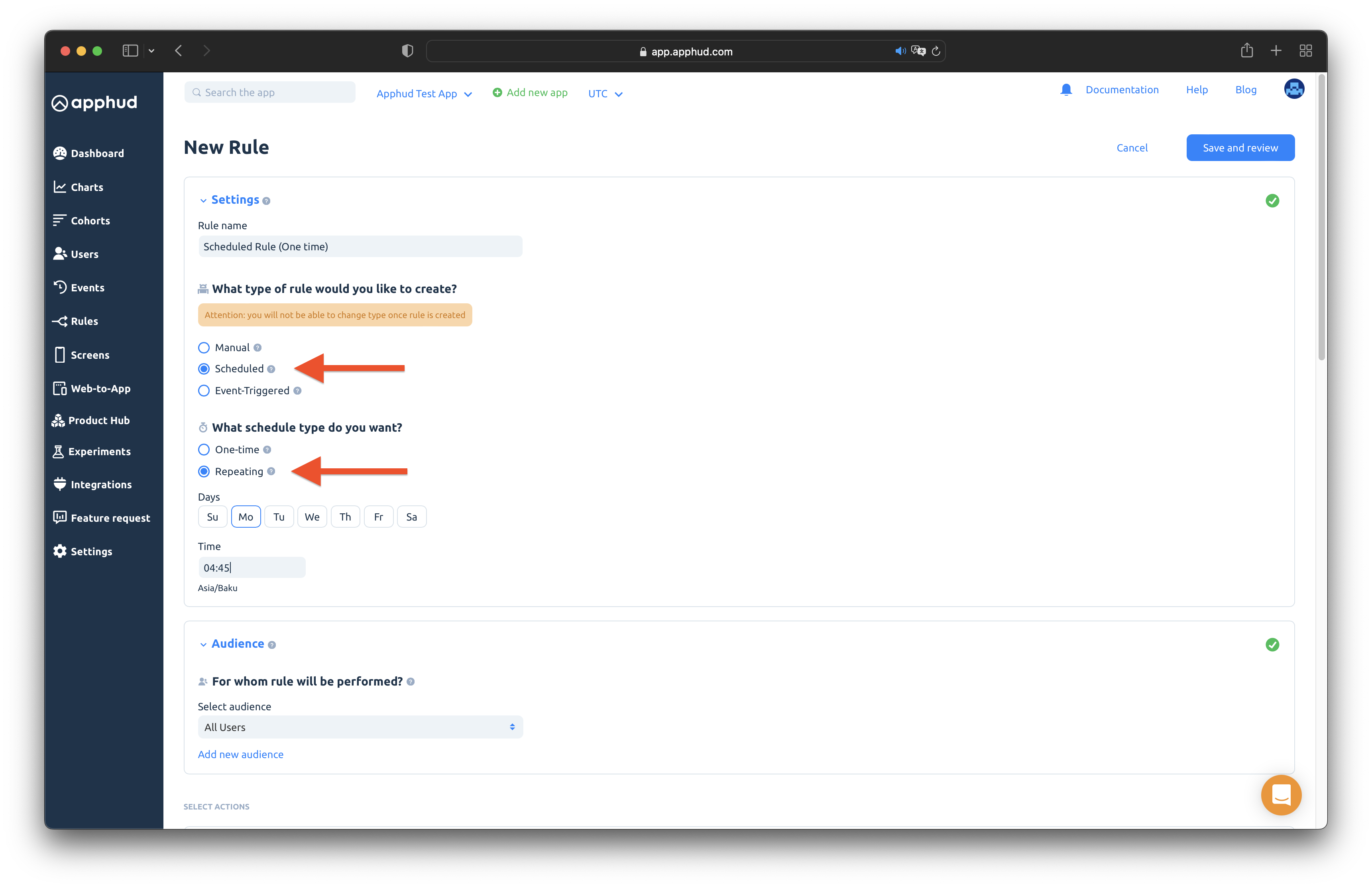
-
Event-Triggered - For an event-triggered rule, you can set a delay that is limited to 24 hours max. After the timer fires, a push notification will be sent to a user. And if a user opens an app, an in-app interaction, if set, will be triggered as well.
- "When to perform rule?" option - Choose any triggers to perform the rule.
- "When to execute actions?" option - You can choose whether to perform the rule immediately or after a custom delay using hh/mm format.
- "How many times rule can be performed for each user?" option - You can perform the rule unlimited times per user or only once per user.
- "When to execute actions?" option - You can choose whether to perform the rule immediately or after a custom delay using hh/mm format.
- "When to perform rule?" option - Choose any triggers to perform the rule.
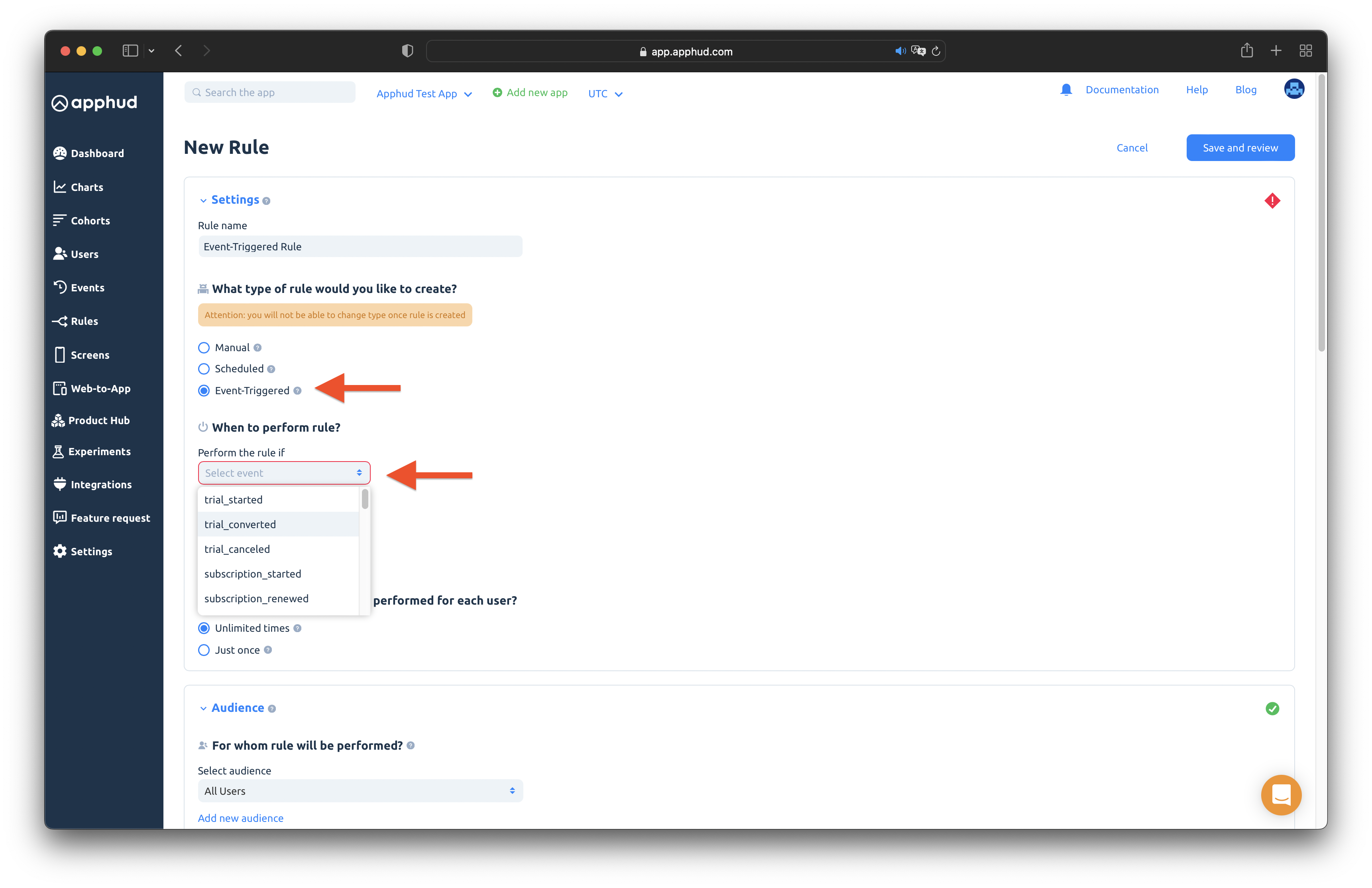
4. User segments
- For whom rule will be performed? Define your target audience. Default is "All Users".

5. Actions
- Send Push notification. Configure Push notification: set up Title (optional) and Text (required). You may localize Push notification.
- Present screen. Select screen that will be shown to a user at next app launch or click "Build new screen".
NoteIn a single run, a Rule can send up to 5 million push notifications. This limit helps maintain system performance and ensures reliable notification delivery.
If the number of targeted users exceeds this limit, notifications will be sent to the first 5 million users meeting the Rule’s conditions, while the rest will not receive notifications in that execution.
For cases where you need to reach more than 5 million users, consider segmenting your audience or adjusting Rule triggering conditions to send notifications in smaller batches.
6. Review your rule and save changes
Don't forget to enable "Enable this rule" checkbox.
7. Rule Statuses
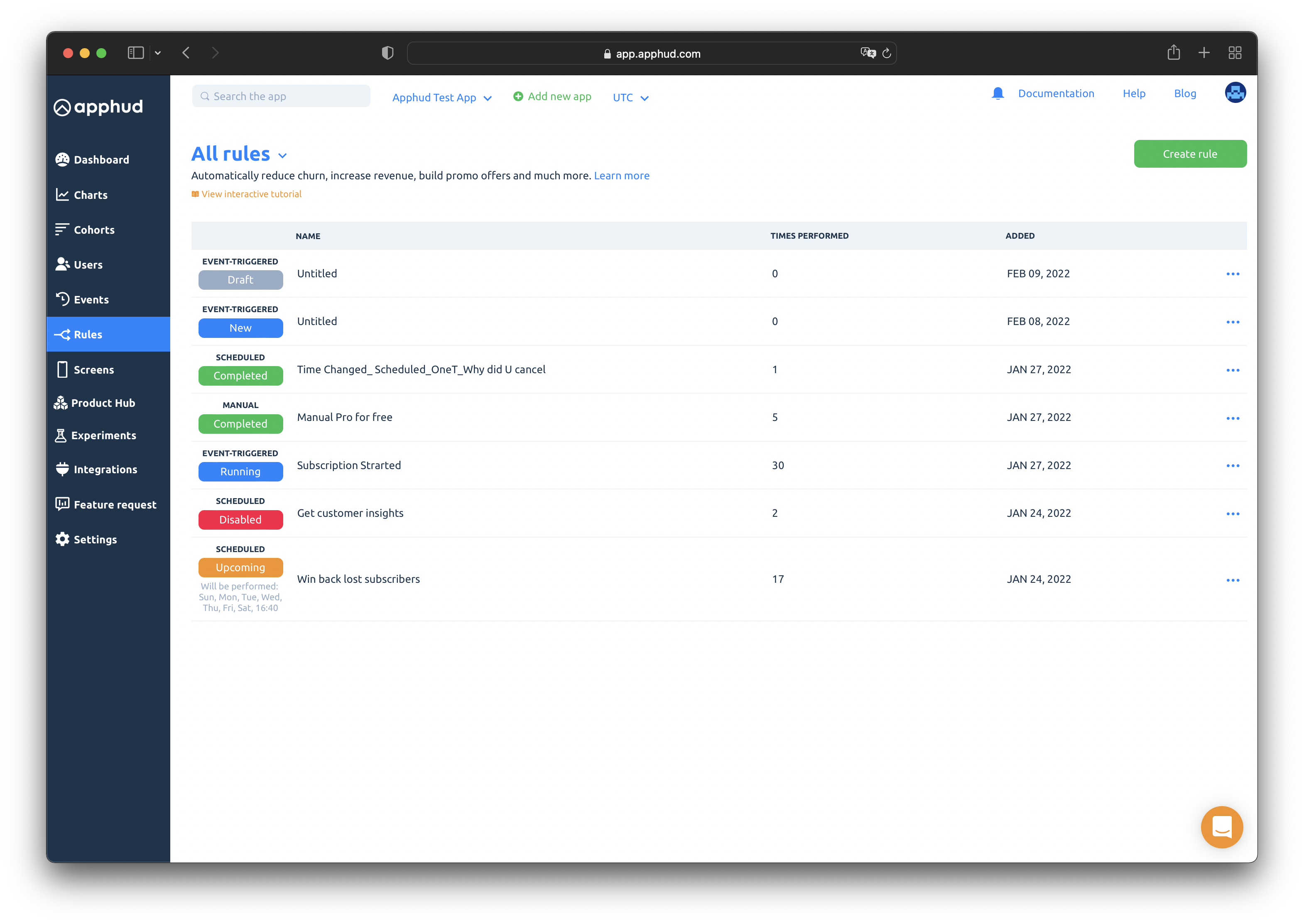
-
Manual Rules:
- DRAFT - The rule is in the creation process and one or more of the mandatory screens are empty.
- NEW - The rule was created but not started.
- RUNNING - The rule is in progress, and push notifications are being sent.
- COMPLETED - All push notifications have been sent.
- DISABLED - The rule has been disabled.
- ARCHIVED - To hide the rule from the main list, click "Archive". It can be recovered (unarchived) for future use.
- DISABLED - The rule has been disabled.
- COMPLETED - All push notifications have been sent.
- RUNNING - The rule is in progress, and push notifications are being sent.
- NEW - The rule was created but not started.
- DRAFT - The rule is in the creation process and one or more of the mandatory screens are empty.
-
Event-triggered Rules:
- DRAFT - The rule is in the creation process and one or more of the mandatory screens are empty.
- NEW - The rule was created but not started.
- RUNNING - Running Rules. They are in this state after launch, waiting for events. Can be edited.
- COMPLETED - All push notifications sent.
- DISABLED - The rule has been disabled.
- ARCHIVED - To hide the rule from the main list, click "Archive". It can be recovered (unarchived) for future use.
- DISABLED - The rule has been disabled.
- COMPLETED - All push notifications sent.
- RUNNING - Running Rules. They are in this state after launch, waiting for events. Can be edited.
- NEW - The rule was created but not started.
- DRAFT - The rule is in the creation process and one or more of the mandatory screens are empty.
-
One-Time Scheduled Rules:
- DRAFT - The rule is in the creation process and one or more of the mandatory screens are empty.
- NEW - The rule was created but not started.
- UPCOMING - Started rules which are waiting for the execution time.
- RUNNING - The rule is in progress, and push notifications are being sent.
- COMPLETED - All push notifications sent.
- DISABLED - The rule has been disabled.
- ARCHIVED - To hide the rule from the main list, click "Archive". It can be recovered (unarchived) for future use.
- DISABLED - The rule has been disabled.
- COMPLETED - All push notifications sent.
- RUNNING - The rule is in progress, and push notifications are being sent.
- UPCOMING - Started rules which are waiting for the execution time.
- NEW - The rule was created but not started.
- DRAFT - The rule is in the creation process and one or more of the mandatory screens are empty.
-
Repeating Scheduled Rules:
- DRAFT - The rule is in the creation process and one or more of the mandatory screens are empty.
- NEW - The rule was created but not started.
- UPCOMING - Started rules which are waiting for the execution time.
- RUNNING - The rule is in progress, and push notifications are being sent.
- COMPLETED - All push notifications sent.
- DISABLED - The rule has been disabled.
- ARCHIVED - To hide the rule from the main list, click "Archive". It can be recovered (unarchived) for future use.
- DISABLED - The rule has been disabled.
- COMPLETED - All push notifications sent.
- RUNNING - The rule is in progress, and push notifications are being sent.
- UPCOMING - Started rules which are waiting for the execution time.
- NEW - The rule was created but not started.
- DRAFT - The rule is in the creation process and one or more of the mandatory screens are empty.
Test Rules
Important NoteTesting Rules using Local StoreKit purchases is not supported. Please use Sandbox purchases using your sandbox Apple ID / password.
To test a rule simply create any and click "Test". Enter user ID on whom you want to test the rule and click Perform now.
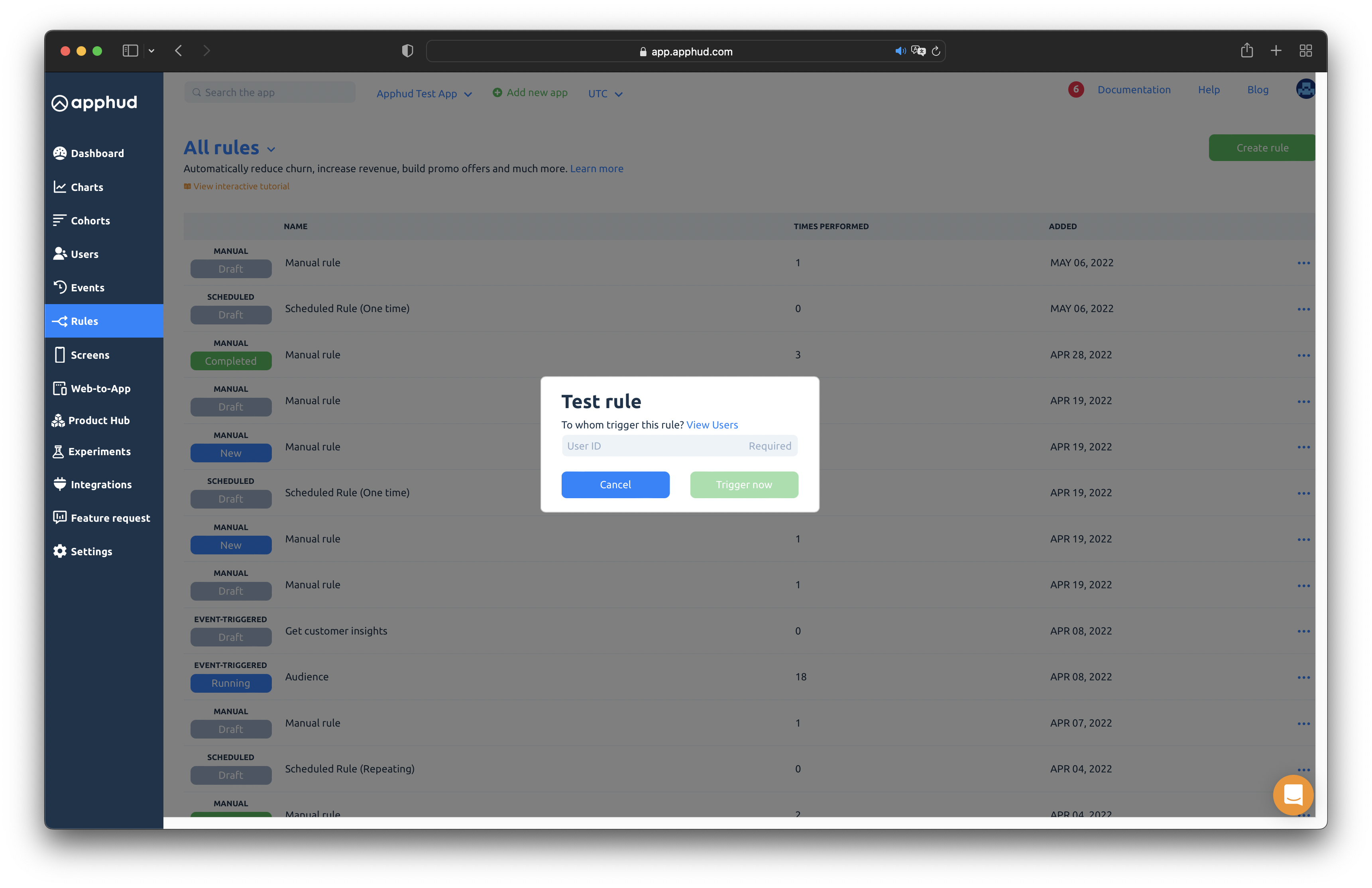
Silent Push Notifications in Rules
You can configure Rules in Apphud to send silent push notifications, which are background notifications that do not display alerts, sounds, or banners to the user. These notifications are useful for automating background tasks such as updating local app data, syncing subscription status, or preparing personalized content.
- No user permission required
- Updates app data in background
- Doesn’t interrupt the user
- Lightweight and fast
- Ideal for syncing, content refresh, and badge updates
Enabling Silent Pushes
When creating or editing a Rule, activate Send Push Notification as the action.
In this section, you will see an option labeled "Send silent push notifications". Enable it.
Enabling this option adds the content-available: 1 flag to the payload, allowing your app to process the push in the background.
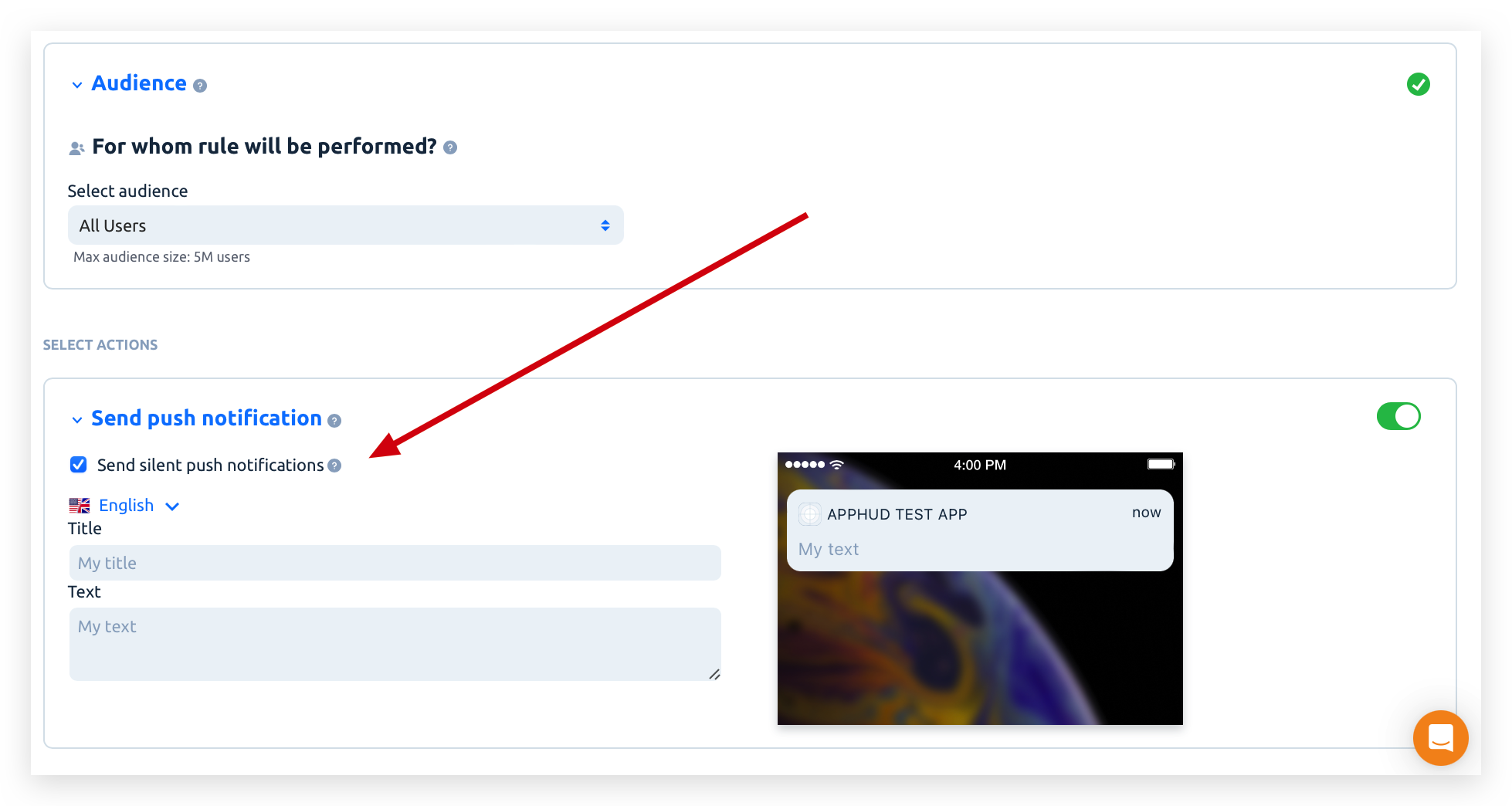
What You Need to Know
Your app must be configured to handle silent push notifications and process the incoming data accordingly.
These notifications do not require explicit user permission to be delivered.
Example Use Cases
Sync subscription status:
When a subscription status changes (e.g., user cancels a trial), Apphud can send a silent push to the app to refresh local data and UI, without waiting for the user to reopen it.
Trigger in-app logic without Alert:
A Rule could trigger a silent push to run specific in-app logic (like showing a custom paywall later or preparing personalized content), all without bothering the user.
Update badge count or local storage:
Automatically update badge counters or local cache in response to backend changes — ideal for reminding users without sending visible notifications.
Support server-less automation:
Instead of integrating your own backend for each trigger, Apphud could handle everything. Apphud detects the event, triggers the Rule, and sends the silent push, eliminating the need to build and maintain your own server logic.
Silent push notifications are a powerful way to automate background processes, reduce app latency, and create smoother user experiences without building custom infrastructure.
Custom Parameters in Rule’s Push Payloads
You can add custom key-value pairs when setting up push notifications in Rules. This gives you greater flexibility to control how notifications behave on iOS devices.
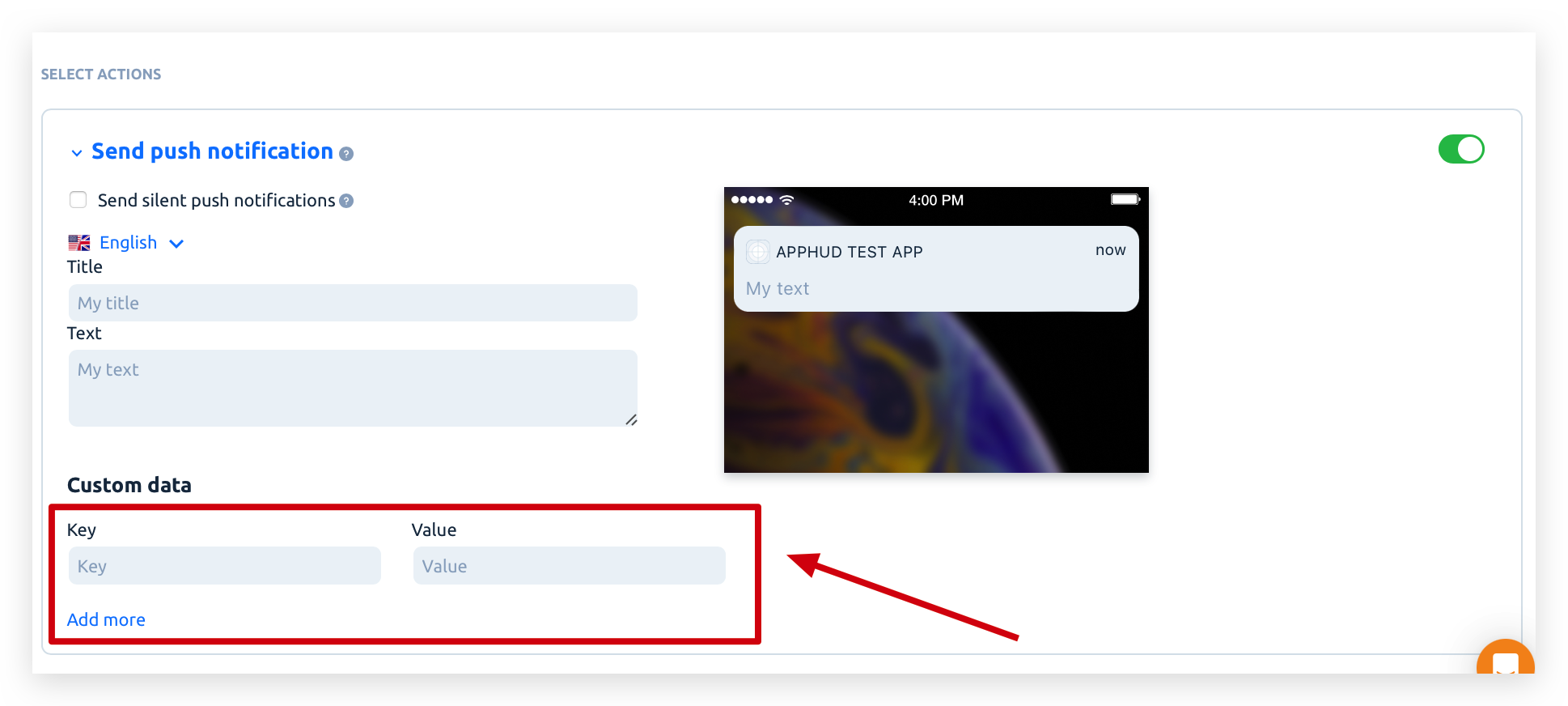
Rules delegate methods (iOS only)
Rules - an array of notifications in Apphud, when the user was shown the rule’s screen then the rule is marked as “Read” and removed from the rule notifications response.
Apphud has the ApphudUIDelegate.swift class to improve the rule’s experience in your project: Include some functions:
func apphudShouldPerformRule-> You can return false to ignore this rule. You should only do this if you want to handle your rules by yourself. A default implementation is true.func apphudShouldShowScreen→ you can return false to this delegate method if you want to delay the Apphud Screen presentation. The controller will be kept in memory until you present it via theApphud.showPendingScreen()method. If you don't want to show the screen at all, you should check theapphudShouldPerformRuledelegate method.func apphudScreenPresentationStyle→ Pass your own modal presentation style to Apphud Screens. This is useful since iOS 13 presents in page sheet style by default. To get the full-screen style you should pass.fullScreenor.overFullScreen.func apphudScreenDidAppear→ Called when the screen successfully loaded and is visible to the user.func apphudDidDismissScreen/apphudScreenWillDismiss→ Notifies that Apphud Screen did dismiss/is about to dismiss.
Analyze Rules
You can view the results of rules efficiency in "Analyze" section. Click "..." and select "Analyze".
Updated 5 months ago
